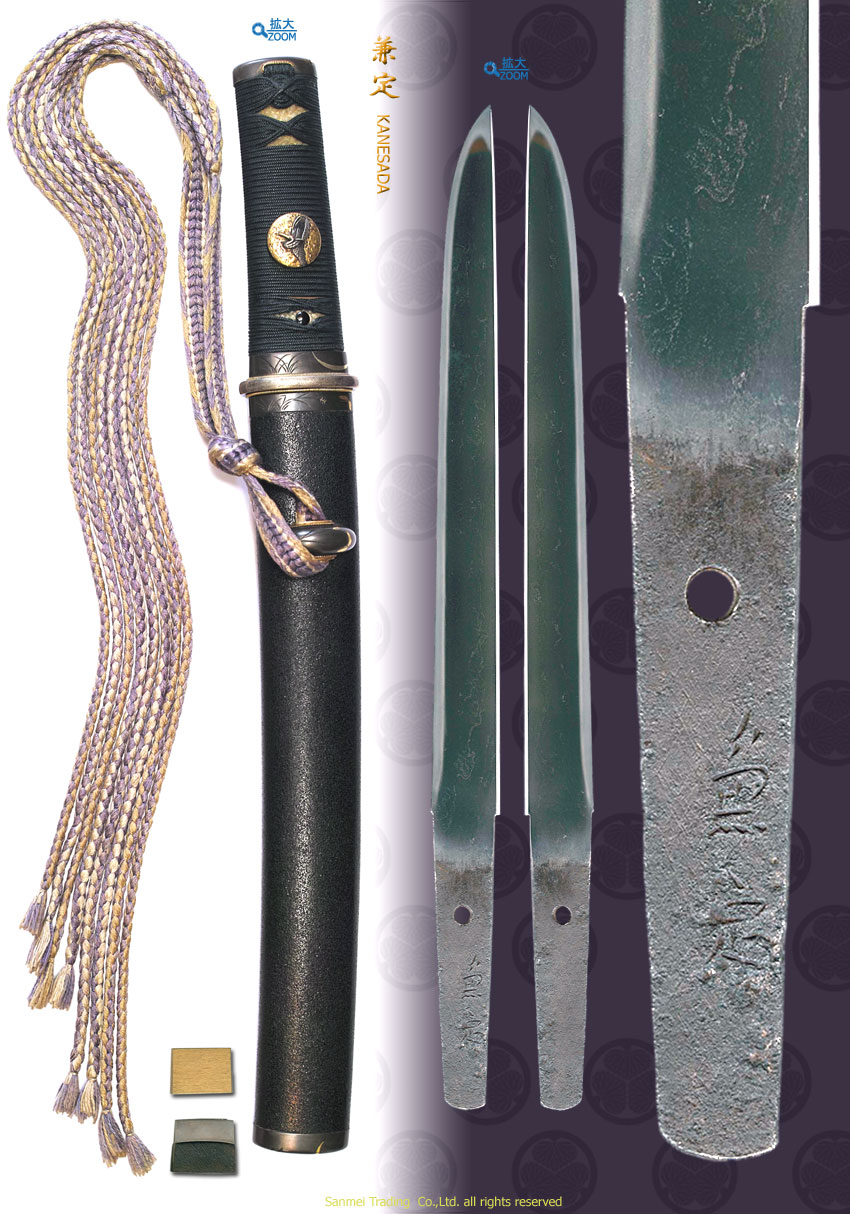with) Black stone surface lacquered scabbard Tanto Koshirae
Length of cutting edge 23.2cm Inward curvature Width of base 22.5mm Thicknes of base 5.3mm
Kitae(forging pattern) : Kitae is conspicuous fine Itame hada generally with the indication of Mokume burl. The entire steel gives off belt-like patches Nie-utsuri of sparkling martensite particles glitter that comes from fine steel quenching process where generates darkish gleaming lines so called Chikei activity.
Hamon(tempering pattern) : Hamon state is "Nie-deki" that is rather on stronger side, starts with very slight Yakiotoshi indication, Suguha with slight undulating Notare. Boundary line is covered thickly with sparkling martensite particles glitter and the interior of temper is filled with misty sparkling Nioi where is shining brightly.
Boshi (tip): Upper the Fukura area toward tip, stronger, thicker and brighter the Nie to perceive delicate Sunagashi area then refined small circle turns back regularly.
Nakago(tang) : The tang is UBU original. One Mekugi-ana retaining hole. "Higaki" crossing filemarks and the back ridge of Nakago is a bit contoured. Shallow Ha-agari-Kurijiri of uneven U-shaped heel. An unsophisticated style of signature KANESADA 兼定 is located lower the tang in front. The entire Nakago preserves an excellent taste of patina of nearly five centuries.
In the battle ages of Muromachi, about Eisho era (1504-20), The famed KANESADA 兼定 epoch-making swordsmith had appeared under the protection of the powerful clan Saito. Apart from the other makers, KANESADA 兼定 used the highest quality steel to make fine art swords, not as being merely weapons and utilitarian objects to meet with requirement from master.
From his extant works with the date of year, his activity period ranges earliest from Bunmei 4 (1472) to the end of Daiei 6 (1526) in 54 years.
In his earlier stage on before Meiou 8 (1499), his signature "SADA" 定 was in square style like this example and changed it to the cursive style so has been called as NOSADA 之定 in his later age.
We can't miss it that he is the first swordsmith who enjoyed an official provincial government title granted by the Imperial Court "Izumi-no-kami" from Eisho 5-7 (1508-10).
In view of his extant works of Suguha, here is an excellent tanto in his early age to follow the examples of Rai-works from kamakura period.
Black stone surface lacquered scabbard Tanto Koshirae consists of : (click HERE for entire image and HERE for each fitting)
- All metal fittings (Fuchi/kashira, Koikuchi, Kurikata, Ura-kawara and Kojiri) : Butterflies flit from Pampas grass under Crescent moon design, Shibuichi ground, Kebori carving Iroe works, unsigned
- Menuki : Cranes fly against the sun and the moon design, Copper ground Takabori carving, Iroe works
- Tsuba : Mumon design of polish plain surface, silver ground, unsigned
- Kozuka : Butterflies flit from Pampas grass design, Shibuichi ground, Kebori
carving, Iroe works, four-character compound word of longevity 千秋万歳 Sen-shu-ban-zai
signed I'kkin (seal) 一琴(花押)
reference data : Suzuki Takuo/Sugiura Yoshiyuki, Muromachi-ki Mino-toko no kenkyu, 2006

